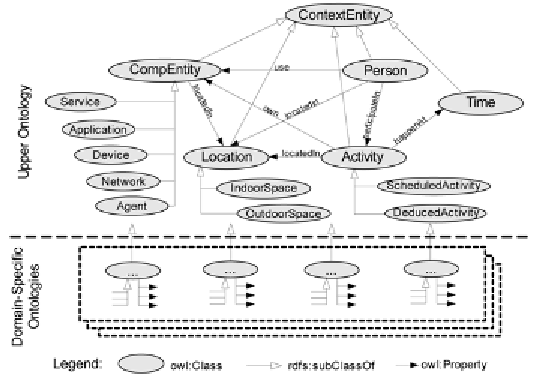Information Technology Reference
In-Depth Information
Figure 1. An example of ontology for illustration
to generate the merged ontology for clustering
peer and select the affected properties defined in
the upper ontology to generate the merged ontol-
ogy for clustering queries. With this scheme, a
peer can extract the semantics of its data triples
more precisely without losing generality for con-
text queries. For example, predicate
locatedIn
may have the
rdfs:range
of
IndoorSpace
in the
merged ontology for clustering peers (see Figure
2a) and have the
rdfs:range
of
Location
in the
merged ontology for clustering queries (see Fig-
ure 2b). Data triple
<socam:John socam:locatedIn
socam:Bedroom>
will be mapped to
IndoorSpace
;
and query
<socam:John socam:locatedIn ?x>
will be mapped to both
IndoorSpace
and
Out-
doorSpace
rather than only
IndoorSpace
. This is
most likely the case of real life applications.
triples and participate in the lower-tier network.
As a node may obtain multiple semantics from
its local data, we choose the semantic cluster
corresponding to the largest set of data to place
the node. We call this semantic cluster the major
semantic cluster of this node. The remaining se-
mantic clusters which a node's data corresponds
to are called minor semantic clusters of this node.
A node is assigned with an ID upon joining the
network. We use SHA1 hash function to generate
nodes' identifier space. To incorporate semantic
information associated with a node, we dedicate
part of hashed node identifiers to correspond to
the semantic cluster. More specifically, in a
k
-bits
identifier space, we allocate
m
-bits for semantic
cluster information and
n
-bits for its IP address,
where
k
=
m
+
n
. An example of a node's ID gen-
erated by hashing its semantic cluster
Person
and
its IP address “137.132.81.235” is given below.
THE UPPER-TIER NETWORK
node id = [hash
m
(“Person”)]
[hash
n
(“137.132.81.235”)]
In this section, we describe the process of con-
structing the two-tier semantic P2P network. After
obtaining the semantics from its local context
data, a node needs to participate in the network.
It will first join an appropriate semantic cluster
in the upper-tier network, and then store its data
With this encoding scheme, we are able to
construct the two-tier network and identify a node
in the network, i.e., the first
m
-bits of a node's ID
(called
semantic cluster ID
or
sid
in short) cor-

Search WWH ::

Custom Search